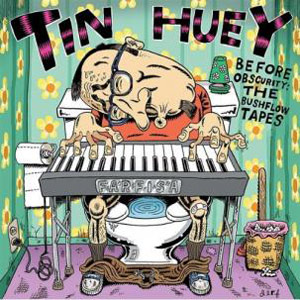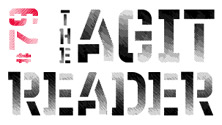
Before Obscurity: The Bushflow Tapes
Smog Veil
Does this sound familiar? Leftfield band stumbles into a surprising commercial hit; record scouts scour the scene for the next big thing with checkbooks ablaze. None of the second wave bands make any noise, and the carnival moves on leaving the bands and the locale in the dust. The list of cities reads like a rock fan’s fantasy travel itinerary: Seattle, Athens, Chicago, and... would you believe Akron, Ohio?
On the heels of Devo’s rising success and a Stiff Records Akron compilation in 1978, legendary Village Voice music critic Robert Christgau journeyed for a first-hand experience of the “Akron sound.” On that faithful trip, he witnessed the five-man band known as Tin Huey. Not as conceptual as Devo, but still pushing the borders of rock music, Tin Huey wasn’t exactly a safe commercial bet. Still, the band—comprised of Harvey Gold (guitar/vocals), Mark Price (bass/vocals), Ralph Carney (saxophone), Stuart Austin (drums) and Chris Butler (keyboards/vocals)—impressed Christgau so much that he recommended that Warner Bros. A&R rep Karin Berg go and see the band play. Berg was so impressed that she invited her boss, and in short order, Tin Huey was signed to Warner.
To quote Run-DMC, “You all know how the story goes!” The band flies to LA to record its debut album, Contents Dislodged During Shipment, in the summer of ’78. The record is released in the spring of ’79 and promptly goes double-zinc. Soon after, the band is released from its contract and goes back to the local grind. There’s some more recording, a couple of single releases, then the band relocates piecemeal to various parts of New York state, does some touring and records a follow-up record that’s never released. Life eventually comes calling and the band members answered in various ways. Carney played with Tom Waits, the B-52s and a laundry list of other musicians. Butler forms the Waitresses and later the dBs, then moves on to producing, while the other band members pursued vocations like guitar-making and electrical engineering. Price continued to work as a producer for his own Bushflow Studios.
It’s the recordings that Price made with the band that make up the release Before Obscurity: The Bushflow Tapes. The majority of the album is songs recorded between ’78 and ’79, with a live four-song coda from ’73. This isn’t the first re-emergence of Tin Huey, the second record, Disinformation, was finally released in 1999, and after some nostalgic buzz in 2004, the band has been playing sporadically in Cleveland and Akron in various forms ever since. So this record is a smile and a shrug, filling in the blanks of before they were contenders.
It’s quite a grab bag of styles that appear on the record, and if you didn’t know better, it would seem like a compilation of at least four or five different bands. There’s R&B styled dance tunes (“Slide”), Bowie/McCartney-esque rave-ups (“Sister Rose”), experimental fractured tunes (“Reml”), and even a legit take on the Stooges’ “I Wanna Be Your Dog.” It’s almost shocking at how effortless they shift styles, making every song sound like their definitive style. Before Obscurity is full of gems. One of the biggest revelations is the first live appearance by the Waitresses (in this incarnation Tin Huey and Patty Donahue) on the sassy “The Comb,” which sounds like a pre-cursor to the latter Waitresses’ “I Know What Boys Like” and Blur’s “Boys & Girls.” It’s not the same version of the band from ’78, but it’s interesting to see where they started out.
While Price passed away in 2008, it’s good that his legacy and that of Tin Huey will live on with Before Obscurity. While it may not entirely pull the band from obscurity, it does shine a light on a forgotten corner of music.
Dorian S. Ham
PAST PERFECTS
Interference, Interference
U2, The Unforgettable Fire
Isaac Hayes, Shaft
Pylon, Chomp More
Nirvana, Bleach
Harmonia and Eno '76, Tracks and Traces
Fela Kuti, The Best of the Black President
Siouxsie and the Banshees, Juju
Gary Higgins, Seconds
Where the Action Is! Los Angeles Nuggets 1965-1968
Big Star, Keep an Eye on the Sky
Sunny Day Real Estate, Diary and LP2
The Feelies, Crazy Rhythms and The Good Earth
Thrasher Magazine's Skate Rock Volume 1
